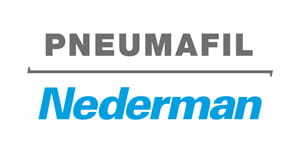Inlet Static systems using replaceable media for air streams with finer particulate.

The Pneumafil multi-stage static intake air systems use a combination of time proven filtration components to provide high quality gas turbine inlet air. Each stage has a separate and distinct function that is vital to the overall system performance.
Selection of the various stages of the system depends on the environmental conditions that will be encountered. The first stage of inlet filtration will consist of either a weather louver section or a weather hood section. For environments subject to frequent periods of fog or mists, the weather hood option with integral droplet eliminator should be chosen.
For areas with heavy particulate concentrations (higher than 0.1 mg/m3), the inertial separator may be chosen as the second stage. Because this section cleans the air by inertial separation it has a constant arrestance efficiency under the most severe particulate loading. In such environments the inertial section is necessary for adequate protection of subsequent stages of filtration that would otherwise quickly become plugged by the heavy concentration. However, pulse cleaned systems are often preferable for these conditions because they provide lower pressure drop over the long term.
The third stage of filtration in the inlet system is selected from the Pneumafil product line of medium efficiency, high dust holding capacity prefilters, each of which are available in several efficiency grades and pleat depths. Prefilters and high efficiency, final stage filters are selected to form an optimized “system” to provide best efficiency, pressure drop and life.
The final stage of filtration for the multi-stage system is selected from the Pneumafil product line of Turbine Mini-Pleat high efficiency static barrier air filters. Air filters are available in two fiber types, Micro-glass and 100% synthetic. Filters can be designed in either standard depth (12”) or extended depth (17”). Efficiency ranges from ASHRAE - MERV 14 / EN779 – F8 through ASHRAE – MERV 16 / EN779 F9 *. Systems can also be supplied with HEPA E10 rated filter products which enables Pneumafil engineers to select the most economical match for your operating environment. See the filter testing comparison chart
A static, or barrier-type inlet system is usually made up of a series of modules, which house filter elements, arranged to feed into a common, clean air plenum. Disposable filter elements are installed in a structural grid, or, holding frame. In some cases, these holding frames are equipped with drain troughs to carry away collected moisture. Filter modules feature a walk-in service area used during installation, inspection and change-out of filter elements. Modules ship with all wiring and lighting installed and terminated at a small junction box outside the access door. The filter modules often house a moisture removal section with vertical eliminator blades, droplet eliminators or coalescers. If the system features rain hoods, these are mounted on the filter modules inlet faces.
Static systems are well-suited for all environments where the air contaminants are hydrocarbons or very fine particles. This type of contaminant is either too “sticky” or too light to be dislodged by the pulsing action of a self-cleaning inlet system. For example, we have provided several static systems that have HEPA grade efficiency (i.e. 99.97% efficient on particles of 0.3 micron).
By selecting and combining a wide variety of filter elements, we can achieve an infinitely variable range of efficiency and performance characteristics to meet the needs of each customer’s engine.